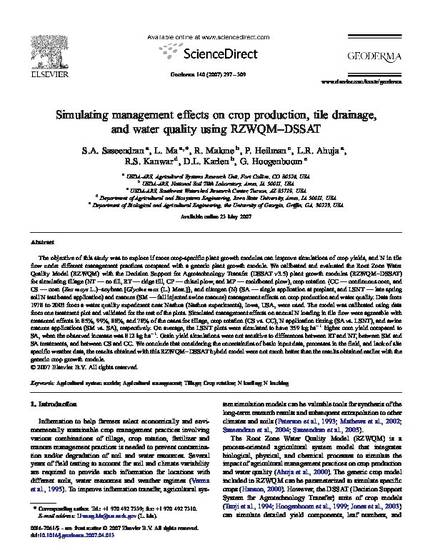
The objective of this study was to explore if more crop-specific plant growth modules can improve simulations of crop yields, and N in tile flow under different management practices compared with a generic plant growth module. We calibrated and evaluated the Root Zone Water Quality Model (RZWQM) with the Decision Support for Agrotechnology Transfer (DSSAT v3.5) plant growth modules (RZWQM–DSSAT) for simulating tillage (NT — no till, RT — ridge till, CP — chisel plow, and MP — moldboard plow), crop rotation {CC — continuous corn, and CS — corn (Zea mays L.)–soybean [Glycine max (L.) Merr.]}, and nitrogen (N) (SA — single application at preplant, and LSNT — late spring soil N test based application) and manure (SM — fall injected swine manure) management effects on crop production and water quality. Data from 1978 to 2003 from a water quality experiment near Nashua (Nashua experiments), Iowa, USA, were used. The model was calibrated using data from one treatment plot and validated for the rest of the plots. Simulated management effects on annual N loading in tile flow were agreeable with measured effects in 85%, 99%, 88%, and 78% of the cases for tillage, crop rotation (CS vs. CC), N application timing (SA vs. LSNT), and swine manure applications (SM vs. SA), respectively. On average, the LSNT plots were simulated to have 359 kg ha− 1 higher corn yield compared to SA, when the observed increase was 812 kg ha− 1. Grain yield simulations were not sensitive to differences between RT and NT, between SM and SA treatments, and between CS and CC. We conclude that considering the uncertainties of basic input data, processes in the field, and lack of site specific weather data, the results obtained with this RZWQM–DSSAT hybrid model were not much better than the results obtained earlier with the generic crop growth module.
Available at: http://works.bepress.com/douglas_karlen/46/

This article is from Geoderma 140 (2007): 297–309, doi:10.1016/j.geoderma.2007.04.013.